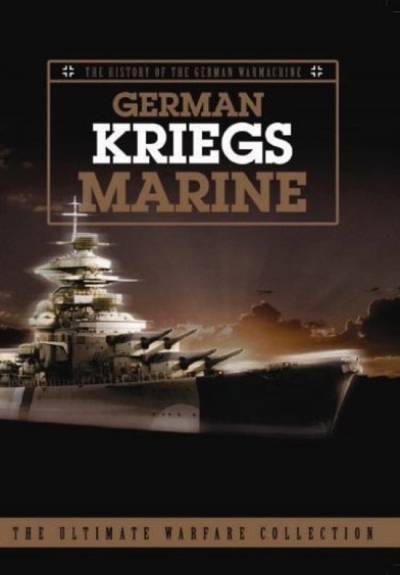| Title: | German Kriegsmarine |
| Released: | 2007 |
| Publisher: | Kolmio Media |
| Play time: | 82 minutes |
| Description |
The documentary 'German Kriegsmarine' from the series 'the history of the German war machine' sketches an excellent picture of the rise and fall of the German naval forces between 1914 and 1945. It is clear that German submarines in particular were very successful against allied ships during the First World War (1914-1918). These submarines soon proved to be a very effective weapon against merchant ships and other ships. The First World War was primarily a land war in which decisive battles were won or lost. The defeat of the German Empire in 1918 and the subsequent Treaty of Versailles in 1919 in fact meant the end of most of the German war fleet. Nevertheless, work was being done in the Interbellum on the construction of ships. The first important ship that was built after the war was the light cruiser Emden. The rise of Adolf Hitler (1889-1945) and his seizure of power meant the reconstruction of the German war fleet. Navy Commander-in-Chief Erich Raeder (1876-1960) stressed that submarines were essential for waging naval war against the Allies. Great Britain could be cut off from supplies elsewhere in the world with the help of submarines and merchant ships were easy targets. The construction of cruisers and battleships took place in Germany where powerful ships were built. The most famous battleships are of course the Bismarck and sister ship Tirpitz, which were very powerful battleships with a length of 251 meters and an armament of eight 380mm /14.96in cannons. The documentary examines these facts and outlines the various developments in shipbuilding and deployment with the help of black and white images. The documentary extensively examines the role played by submarines (U-boats) during the Second World War. Different types of submarines were built. The 'unlimited submarine war' was unleashed by Hitler Germany against the (Western) Allies, with ships from Great Britain and the United States in particular being targeted. The German submarine captains, who sunk dozens of allied ships and warships, were welcomed in Germany as heroes, who were an excellent example for future U-boat crews. The fact is that Allied weapons were used to sink German submarines. Consider the depth charges. Also the cracking of the codes of the Enigma cipher machine contributed to this (so German messages could be intercepted), the good radar installations of the allied ships and the ASDIC sonar equipment. The depth charges were usually launched from destroyers, after which the explosives exploded in the water. Usually this happened at a depth where (possibly) German submarines were located. Yet, it is clear that less money was spent on the navy of Hitler-Germany than on the land army (especially on the Wehrmacht and the Waffen-SS). The German navy was in fact given less priority. She did not have many large ships: the Scharnhorst, the Gneisenau, the Bismarck and the Tirpitz were the largest giants. Aircraft carriers were completely absent from the German arsenal of weapons, except for the never completed Graf Zeppelin. Again, it was the submarines that excelled in numbers. Approximately 1,153 to 1,156 German U-boats were produced in different ship yards between 1935 and 1945. These submarines sunk millions of tons of Allied shipping. The fact is that some submarines even reached the coast of North America. However, the reinforced convoys, which increasingly consisted of transport ships and destroyers, became gradually more difficult targets. The U-boats, for example, increasingly had to attack in large numbers to be successful. The depth charges and allied reconnaissance aircraft were major threats to U-boat crews. The German navy was a formidable weapon during the Second World War. This is clearly shown in the documentary. The excellent submarines and the enormous battleships (Bismarck and Tirpitz) made a big impression on the Allies. Nevertheless, the ambitious 'Z-Plan' could not be completed. That plan was to make the German seagoing fleet supreme, whereby aircraft carriers also had to be built. The enormous cost of building the ships was ultimately the reason for Hitler and his staff to abandon the implementation of the plan. The Luftwaffe and the army were able to use the material well, and many of the material and raw materials intended for ships were spent on planes and ground weapons. The defeat of the Third Reich was mainly decided on the ground on the Eastern Front. The Allied invasion in 1944 led to the opening of a second front, which caused the Third Reich to be attacked from different sides. The German submarines and the remaining ships could not turn the tide. Just like the Third Reich, the German navy was defeated. Just like the Third Reich, the German naval force was defeated. After the war, the Kriegsmarine was dissolved. All in all, the documentary is very interesting and gives a detailed picture of the rise and fall of the German Kriegsmarine! |
| Rating: |     (Very good) (Very good) |
Information
- Translated by:
- Fernando Lynch
- Article by:
- Ruben Krutzen
- Published on:
- 27-05-2019
Images


